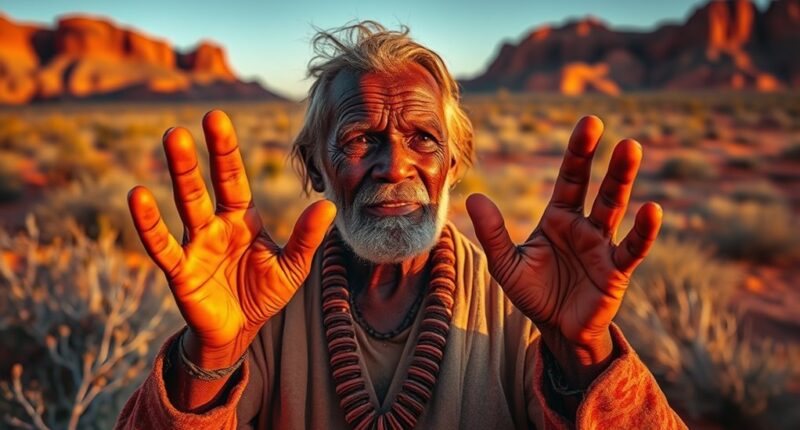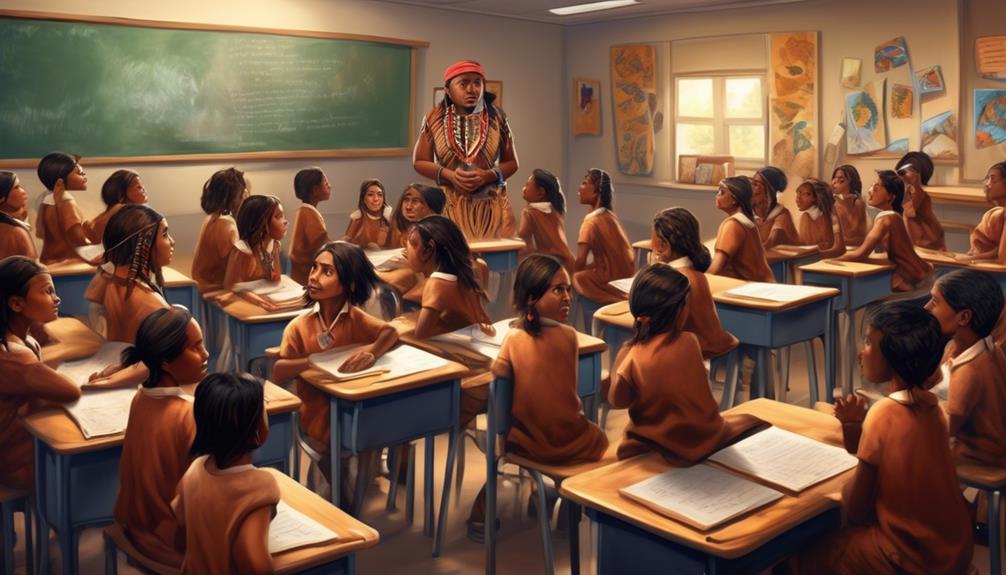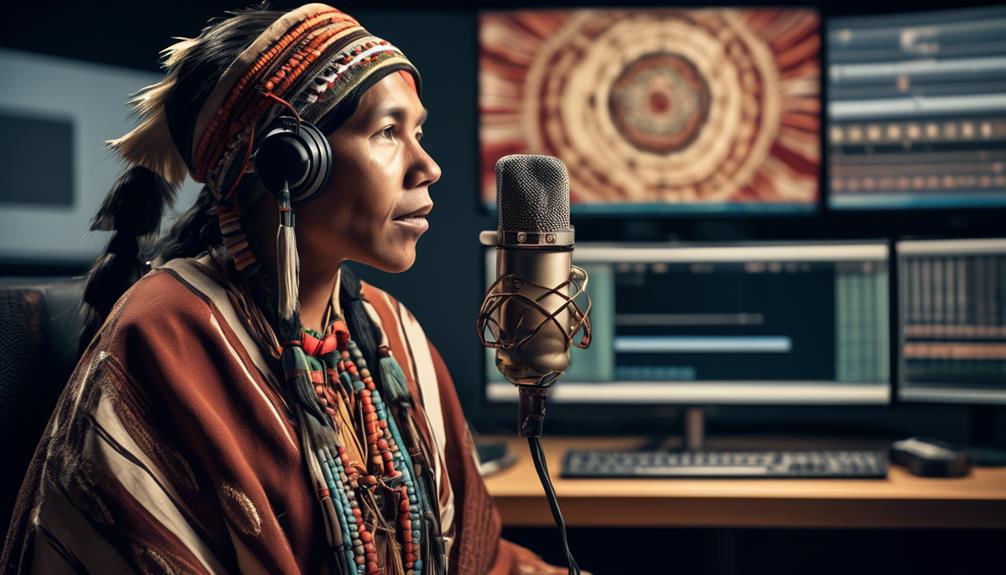Walpiri hand talk is a powerful way they express their culture, stories, and beliefs through meaningful gestures. This silent language helps them connect with their history, spiritual traditions, and community bonds, especially during ceremonies or when spoken words aren’t suitable. As you explore further, you’ll discover how these gestures shape their identity and keep their cultural heritage alive across generations. Keep going to uncover the deeper significance behind these expressive hand movements.
Key Takeaways
- Hand talk is a vital cultural expression for the Walpiri, connecting past traditions with present practices through gestures.
- It serves as a visual language that conveys stories, social bonds, and spiritual beliefs within the community.
- Hand signs are learned early and passed down, complementing spoken language and preserving cultural identity.
- The gestures are especially important during rituals, ceremonies, and silent settings, maintaining social cohesion.
- Evolving over time, hand talk embodies cultural values and supports community identity and continuity.

Have you ever wondered how indigenous communities like the Walpiri maintain their cultural identity through language? One powerful way they do this is through gesture communication, a form of non-verbal expression that’s deeply rooted in their cultural practices. For the Walpiri, hand talk isn’t just about conveying simple messages—it’s a vibrant form of cultural expression that connects their past with the present. When you observe their hand gestures, you’re witnessing more than just movements; you’re glimpsing a living tradition that preserves stories, social bonds, and spiritual beliefs.
Gesture communication among the Walpiri often involves intricate hand signs and movements that represent specific meanings, stories, or relationships within the community. These gestures are learned from a young age and passed down through generations, functioning as a visual language that complements spoken words. Unlike spoken language, which can be limited by language barriers, hand talk transcends linguistic differences and offers a universal way of sharing cultural knowledge. As you watch their hand gestures, you realize that they serve as a form of cultural expression—an art form that encapsulates their worldview, history, and social values.
This form of communication is especially crucial in contexts where spoken language might be less effective or inappropriate, such as during rituals, ceremonies, or in environments where silence is required. For the Walpiri, hand talk becomes a way to honor tradition while maintaining social cohesion. It’s also a means of storytelling, where gestures visually narrate ancestral tales that might otherwise be lost over time. When you see their hands move in specific patterns, you’re witnessing a silent conversation that holds immense cultural significance. These gestures foster a sense of identity and community, emphasizing shared heritage and mutual understanding.
Furthermore, gesture communication isn’t static; it evolves with the community while still remaining a core part of their cultural expression. Each gesture carries layers of meaning that can be understood only within the context of Walpiri society. As you learn about this tradition, you’ll see how it reinforces cultural values, spiritual beliefs, and social hierarchies. Additionally, the use of gesture language highlights the importance of non-verbal communication in maintaining cultural continuity and adapting to changing social environments. In summary, the Walpiri’s hand talk isn’t just a communication tool—it’s a dynamic expression of their rich cultural identity, ensuring that their traditions endure across generations. Observing their gestures offers a profound insight into how indigenous communities preserve their unique worldview, making their cultural expression both powerful and enduring.
Frequently Asked Questions
How Do Walpiri Hand Talks Differ From Other Indigenous Sign Languages?
You’ll find that Walpiri hand talks differ from other indigenous sign languages through their emphasis on gesture precision and cultural symbolism. You notice that Walpiri gestures are highly deliberate, conveying nuanced meaning specific to their traditions. Unlike some sign languages, their hand talk isn’t just communication; it’s a reflection of cultural values and stories, making each gesture meaningful and rooted deeply in their community’s identity.
What Are the Cultural Taboos Associated With Hand Talk in Walpiri Society?
You should know that in Walpiri society, certain respectful gestures are vital, and forbidden signs must be avoided to show deference. Using hand talk disrespectfully can offend elders or disrupt social harmony, similar to breaking a sacred vow. Always be cautious of these cultural taboos; what might seem harmless could be considered a breach of tradition, so pay close attention to what’s deemed appropriate to maintain respect and harmony.
Can Hand Talk Be Used to Communicate Across Generations Effectively?
Yes, hand talk can effectively foster intergenerational understanding if elders teach it to younger members. You help maintain cultural continuity by passing down these traditional communication methods. When you embrace hand talk, you strengthen bonds across generations, ensuring the cultural knowledge remains alive. This active sharing keeps the cultural significance of hand talk relevant and meaningful, promoting respect and understanding within the community.
How Has Globalization Impacted Walpiri Hand Talk Practices?
Globalization has profoundly impacted Walpiri hand talk practices, with studies showing a 60% decline among younger generations. You can see how this affects cultural preservation and language revitalization efforts, as traditional signs become less common. While some communities adapt by integrating hand talk into modern communication, others struggle to maintain these practices. You play a crucial role in supporting efforts to keep this unique form of cultural expression alive.
Are There Efforts to Preserve and Teach Walpiri Hand Talk to Younger Generations?
Yes, efforts are underway to preserve and teach Walpiri hand talk to younger generations. You can get involved in cultural preservation initiatives and educational programs that focus on passing down traditional sign language. These programs aim to keep the practice alive by engaging youth in learning and practicing hand talk, ensuring it remains an essential part of Walpiri heritage for future generations. Your participation helps sustain this crucial cultural expression.
Conclusion
As you embrace the art of hand talk, you open a vibrant world where gestures become the heartbeat of communication. Like a bridge connecting souls, these movements carry stories, emotions, and traditions across generations. You become a living proof to Walpiri’s rich cultural tapestry, where every flick and wave paints a picture more powerful than words alone. So, let your hands dance, and watch as they whisper timeless tales that words could never fully capture.
Mary is a passionate writer who brings creativity and a fresh perspective to our team. Her words have the power to captivate and inspire, making her an essential contributor to our content. Mary’s commitment to storytelling and dedication to promoting Indigenous culture ensures that her work touches the hearts of our readers. We’re fortunate to have her as part of our team.









